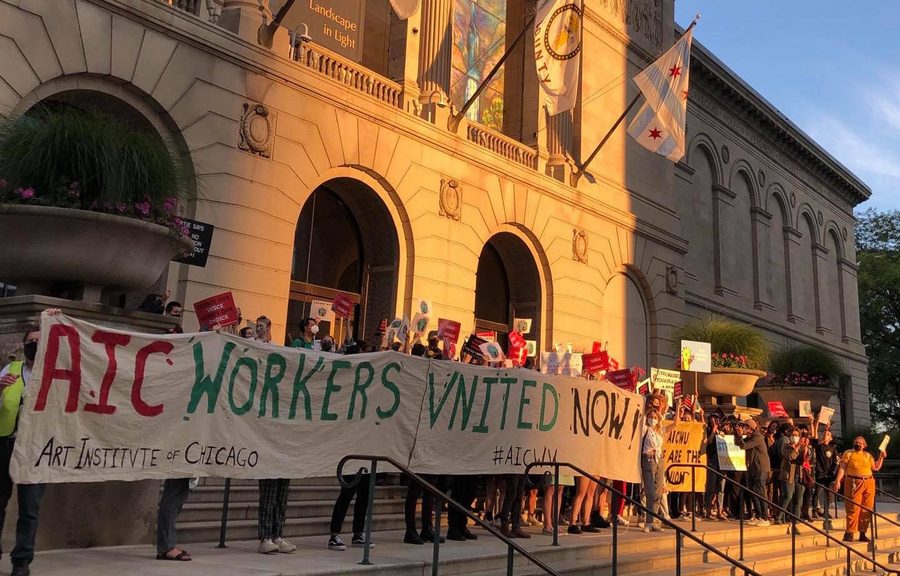An Exhibit of Worker Power: Art Institute of Chicago Workers Join the Museum Union Wave
Employees at the historic museum are organizing for pay fairness and transparency, part of a growing movement to unionize cultural institutions across the country.
Jeff Schuhrke

CHICAGO — On September 9, around 200 Art Institute of Chicago (AIC) and School of the Art Institute of Chicago (SAIC) employees and supporters held a rally in front of the iconic museum to demand that management recognize their union. Standing next to one of the oldest and largest museums in the United States, several of the workers spoke passionately about the need for a union.
“It was so inspiring and galvanizing,” said Erica Warren, textiles curator at AIC. “It was really moving to be there together and feel that energy and solidarity, just to see everyone and have that visual of our strength and the support and the community.”
The unionization campaign is part of a growing movement of museum workers across the country who are organizing to demand equitable pay and increased transparency.
Home to famous paintings like Grant Wood’s American Gothic and Edward Hopper’s Nighthawks, AIC laid off 76 workers in 2020 and furloughed another 109 earlier this year, blaming financial losses caused by having to temporarily shut down for the pandemic.
Having no say in the matter, and citing a lack of accountability from management, the museum’s employees — including curators, art installers, librarians, custodians and gift shop workers — responded by forming Art Institute of Chicago Workers United (AICWU) with backing from AFSCME Council 31.
“My colleagues are amazing and we definitely can do better,” said María Cristina Rivera Ramos, a paper conservator at AIC and an AICWU member. “We just need a bit of power-sharing so that we can also have a voice at the table.”
Motivated by pandemic job cuts and growing pay disparities at cultural institutions, staff at several major art museums have successfully unionized in the past year, including the Philadelphia Museum of Art, Walker Art Center in Minneapolis, and Boston’s Museum of Fine Arts, among many others.
But the current union drive at AIC is unique in that it has expanded to include staff at the neighboring SAIC, a private university and institutional partner of the museum. Last year, SAIC cut 65 full-time positions, 12 part-time positions and 26 contract positions.
Over 300 of the school’s academic advisers, administrative assistants, mailroom workers and other staff are now uniting with their colleagues at the museum by joining AICWU. Workers from the museum and the school say the union campaign is giving them the opportunity to genuinely interact with one another for the first time.
“We’re all really siloed. I don’t know if it’s by design, but it’s made us feel in the past that we’re alone,” explained Rivera Ramos. “But now, hearing stories that resonate with our daily experience and realizing that both the school side and the museum side face very similar issues — when it comes to transparency, to equity and inclusion — has brought us together.”
Myia Brown, assistant director of career and professional experience at SAIC and an AICWU organizer, told In These Times that she has seen many coworkers of color leave the institution because they haven’t been given opportunities for advancement and have lacked a voice on the job.
“We’re really trying to build genuine representation and not just trying to build upon numbers,” Brown said of the union campaign. “We want to make sure everyone is represented in a way that’s authentic to their experiences.”
While the museum recently revamped its mission to promote equity and inclusion, Rivera Ramos said it “sounds so much like lip service,” noting how the full results of a recent pay equity study have not been released by management.
“There’s a lack of competitive salaries, and I think that really impacts retention of high quality, diverse employees,” said AIC’s Warren, also an AICWU member. According to Warren, there are “vast pay disparities” among workers because of lack of transparency around compensation. “With a union contract, we negotiate, and we’ll know what the pay increases are for which positions.”
Despite the recent layoffs and furloughs, AIC reported an endowment of $1.14 billion in 2020, while SAIC had a 15 percent profit margin last year. Meanwhile, the presidents of AIC and SAIC are respectively paid $980,000 and $711,000 per year, with the latter also receiving a monthly “housing allowance” worth $48,000 a year.
AICWU members say they hope management at both the museum and the school will voluntarily recognize the union once a majority of workers have signed union cards. But organizers say both institutions are waging an anti-union campaign with the help of management-side lawyers and a public relations firm.
A spokesperson from AIC told In These Times: “We recognize and support employees’ deciding whether or not to unionize and will continue prioritizing the well-being of our employees — and will work with the union to do so — should they choose to unionize.”
At a virtual meeting last month, the AIC and SAIC workers received inspiration from employees at other cultural institutions who have already won union recognition. AICWU organizers say that hearing from other museum workers who have unionized was reassuring, and helped spark productive organizing conversations.
“The community that’s already forming before we even have our union is amazing,” said Brown.
“People really cherish sitting and talking about what’s important, our priorities and values, and what makes a difference for families in terms of pay and benefits,” Rivera Ramos said. “You can really feel the enthusiasm and the energy that people have.”
Jeff Schuhrke is a labor historian and assistant professor at the Harry Van Arsdale Jr. School of Labor Studies, SUNY Empire State University. He is the author of Blue-Collar Empire: The Untold Story of US Labor’s Global Anticommunist Crusade.







